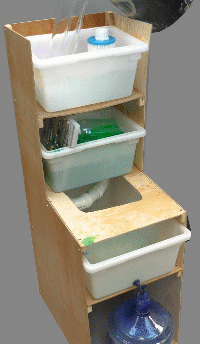The Community Water Project involves communities in building and maintaining their own low-cost, non-electric, safe, drinking water device.
The design plan is in the public domain.
Service learners & educational institutions may collaborate with communities on the project.
Lesson plans are available.
ABOUT
Because the unit has both visible and transparent components, builders and users of the unit can "see" it functioning. Building participants can easily learn, build and troubleshoot due to it's "visual design." Therefore, it helps maximize the usefulness of the unit.
About the Unit
The device consists of a simple filter, a chlorine dosing unit, and a chassis [that holds the components.] Kits for the device can be assembled and shipped to locations where communities can build the device using some of their own locally sourced materials.
The unit is ideal for small communities or schools that have access to non-potable water that needs to be made safe for drinking. For instance, rainwater from roofs, water stored in elevated tanks, or pumped water can be directed into the top of the unit. No electricity is required.
Where it is useful
Community Trust and Safety
The Devices Components
The components of the unit are made predominately from already manufactured components. Other components can be made with a tabletop CNC machine and simple hand tools. Maker Spaces, colleges, and service learners can build the transportable kits.
Service Learning in the Public Domain
The design of the unit is open to anyone including designers, schools, engineering clubs, graduate students, or educational organizations. Improvements and innovations are welcomed. The existing design may not be patented.
Participatory Design and Relationships
The interactive approach to the construction of the unit means that users of the device will collaborate with organizations. This is different than "giving a fish," or even "teaching to fish." Rather it is collaborative learning and work. It's about relationships.


